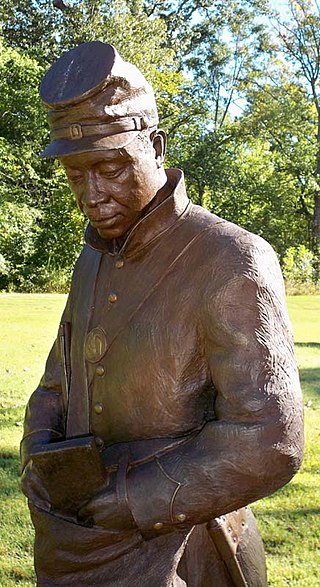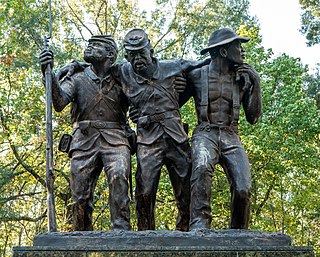
United States Colored Troops (USCT) were Union Army regiments during the American Civil War that primarily comprised African Americans, with soldiers from other ethnic groups also serving in USCT units. Established in response to a demand for more units from Union Army commanders, USCT regiments, which numbered 175 in total by the end of the war in 1865, constituted about one-tenth of the manpower of the army, according to historian Kelly Mezurek, author of For Their Own Cause: The 27th United States Colored Troops. "They served in infantry, artillery, and cavalry." Approximately 20 percent of USCT soldiers were killed in action or died of disease and other causes, a rate about 35 percent higher than that of white Union troops. Numerous USCT soldiers fought with distinction, with 16 receiving the Medal of Honor. The USCT regiments were precursors to the Buffalo Soldier units which fought in the American Indian Wars.

XXII Corps was a corps in the Union Army during the American Civil War. It was created on February 2, 1863, to consist of all troops garrisoned in Washington, D.C., and included three infantry divisions and one of cavalry. Many of its units were transferred to the Army of the Potomac during Grant's Overland Campaign.
The 1st Regiment Alabama Siege Artillery (African Descent) was an artillery regiment recruited from African-Americans that served in the Union Army during the American Civil War. The regiment was renamed the 6th US Colored Heavy Artillery. Under the leadership of Major Lionel Booth, the regiment fought at the Battle of Fort Pillow on April 12, 1864. The regiment then became the 7th US Colored Heavy Artillery, and later the 11th United States Colored Infantry.
The 102nd United States Colored Infantry was an African American infantry regiment of United States Colored Troops in the Union Army during the American Civil War. The unit was organized as the 1st Michigan Colored Volunteer Infantry Regiment before being redesignated as the 102nd Regiment USCT.

The Iron Brigade, also known as The Black Hats, Black Hat Brigade, Iron Brigade of the West, and originally King's Wisconsin Brigade was an infantry brigade in the Union Army of the Potomac during the American Civil War. Although it fought entirely in the Eastern Theater, it was composed of regiments from three Western states that are now within the region of the Midwest. Noted for its excellent discipline, ferocity in battle, and extraordinarily strong morale, the Iron Brigade suffered 1,131 men killed out of 7,257 total enlistments: the highest percentage of loss suffered by any brigade in the United States Army during the war.
The 9th Louisiana Infantry (African Descent), later reorganized as 1st Mississippi Colored Heavy Artillery and then renamed 5th U.S. Colored Heavy Artillery, was an African-American regiment in the Union Army during the American Civil War. It famously fought in the Battle of Milliken's Bend; one of the earliest Civil War battles with African-American troops involved.
Hispanics in the American Civil War fought on both the Union and Confederate sides of the conflict. Not all the Hispanics who fought in the American Civil War were "Hispanic Americans" — in other words citizens of the United States. Many of them were Spanish subjects or nationals from countries in the Caribbean, Central and South America. Some were born in what later became a U.S. territory and therefore did not have the right to U.S. citizenship. It is estimated that approximately 3,500 Hispanics, mostly Mexican-Americans, Puerto Ricans and Cubans living in the United States joined the war: 2,500 for the Confederacy and 1,000 for the Union. This number increased to 10,000 by the end of the war.
The 15th Arkansas Infantry Regiment or Josey's Arkansas Infantry Regiment was an infantry formation in the Confederate States Army during the American Civil War. The regiment was organized in May 1861 under the command of Colonel Patrick Cleburne. It served throughout the war in the western theater, seeing action in the Kentucky, Tennessee, and Georgia campaigns. Following its depletion in numbers the regiment was consolidated several times with other Arkansas regiments, finally merging in 1865 into the 1st Arkansas Consolidated Infantry Regiment. There were two other regiments which also received the designation of "15th Arkansas". The 21st (McRae's) Arkansas Infantry was redesignated 15th Arkansas in February 1863, but to avoid confusion, was normally referred to as the "Northwest regiment". This second "15th Arkansas" was surrendered at Vicksburg in July 1863. A third regiment, under command of Colonels Gee and later Johnson, also received the designation 15th Arkansas Infantry. This last regiment surrendered at Port Hudson, Louisiana, in July 1863.
Alonzo Granville Draper was a volunteer officer in the Union Army during the American Civil War who eventually earned the grade of brevet brigadier general. During his early career, Draper was an outspoken advocate of various social causes, particularly worker's rights. As an officer during the Civil War, Draper was best known as the commander of the 36th United States Colored Troops.

The 55th United States Colored Infantry Regiment was a United States Colored Troops infantry regiment in the Union Army during the American Civil War. It was first organized as the 1st Alabama Volunteer Infantry Regiment (African Descent) in May 1863, serving on garrison duty at Corinth, Mississippi and Memphis, Tennessee. It was redesignated as the 55th United States Colored Infantry in March 1864, continuing its garrison service in Tennessee and fighting at the Battle of Brices Cross Roads. After the end of the war, the regiment was mustered out in late 1865 after garrison duty in Louisiana.
The 56th United States Colored Infantry was an infantry regiment that served in the Union Army during the American Civil War. The regiment was composed of African American enlisted men commanded by white officers and was authorized by the Bureau of Colored Troops which was created by the United States War Department on May 22, 1863. The regiment was originally organized as the 3rd Arkansas Volunteer Infantry (African Descent) on May 22, 1863.

The 46th United States Colored Infantry was an infantry regiment that served in the Union Army during the American Civil War. The unit was originally designated as the 1st Arkansas Infantry Regiment. The regiment was composed of African American enlisted men commanded by white officers and was authorized by the Bureau of Colored Troops which was created by the United States War Department on May 22, 1863.
The 54th United States Colored Infantry was an infantry regiment that served in the Union Army during the American Civil War. The regiment was composed of African American enlisted men commanded by white officers and was authorized by the Bureau of Colored Troops which was created by the United States War Department on May 22, 1863.

The 51st United States Colored Infantry Regiment was an infantry regiment composed of African-American troops recruited from Mississippi that served in the Union Army during the American Civil War. Initially formed in the spring of 1863 as the 1st Regiment Mississippi Volunteer Infantry (African Descent), the Regiment took part in fierce fighting at the Battle of Milliken's Bend, served on garrison duty in Louisiana, and then took part in the Battle of Fort Blakely, the last major battle of the war.
The 118th Field Artillery Regiment is a field artillery regiment of the Georgia Army National Guard. The regiment's 1st Battalion is the cannon battalion assigned to the 48th Infantry Brigade Combat Team. It is one of several National Guard units with colonial roots and campaign credit for the War of 1812.

The 623rd Field Artillery Regiment (Morgan's Men) is a single-battalion unit of the Kentucky Army National Guard. The unit draws its lineage from cavalry and infantry units of the Kentucky Militia formed in 1846 for service in the Mexican–American War. Its antecedents include units that served on both sides of the American Civil War as well as those that fought for the United States in the Spanish–American War, World War One and World War Two. The unit was first designated as the 623rd Field Artillery Battalion in 1947, serving under that name in the Korean War. It was part of the 138th Artillery Regiment in the 1960s before becoming the 623rd Artillery Regiment in 1969 and the 623rd Field Artillery Regiment in 1972. The unit served in the Gulf War as a self-propelled artillery unit; it is now equipped with the M142 HIMARS system.
The 2nd North Carolina Union Volunteer Infantry Regiment was a military unit in the Union Army during the American Civil War recruited from coastal counties in North Carolina. The Regiment was made up of Southern Unionists and deserters from the Confederate Army. After being captured in the Battle of New Bern by Confederate forces under General George Pickett, 22 soldiers of the 2nd Volunteers were executed as Confederate deserters in February 1864.
The 1st North Carolina Union Volunteer Infantry Regiment was a military unit of the Union Army during the American Civil War recruited from coastal counties in North Carolina. The Regiment was made up of Southern Unionists and deserters from the Confederate Army, and fought in several battles in North Carolina before being disbanded in the summer of 1865.








